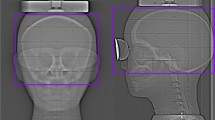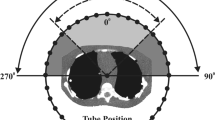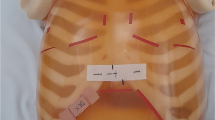Abstract
A new organ-based tube current modulation (NOB-TCM) method was designed with the intent to decrease tube current by 30% over a prescribed 90° radial arc across the anterior aspect of the radiosensitive organ, without increasing tube current in the remaining radial arc. We compared a reference scan and five other dose-reducing methods with regard to effects on dose, practicality, and image quality to determine the most effective method for the reduction of the radiation dose to the eyes during CT examinations of the head. We compared the radiation doses to the eyes and physical image quality in different regions of interest for TCM and shielding scans. Three types of TCM scans were performed: longitudinal TCM, angular TCM, and NOB-TCM. A bismuth sheet and lead goggles were each applied for the shielding scan. Relative to the reference scan, the dose to the eye was reduced to 25.88% with NOB-TCM, 44.53% with lead goggles, and 36.91% with a bismuth shield. Relative to the reference scan, the mean signal-to-noise ratio (SNR) was decreased to 8.02% with NOB-TCM, 28.36% with lead goggles, and 32.95% with the bismuth shield. The SNR of the anterior region of interest was decreased to 11.89% with NOB-TCM and 87.89% with the bismuth shield. The average figure of merit was increased by 11.7% with longitudinal TCM and 13.39% with NOB-TCM, compared with the reference scan. NOB-TCM is a superior solution for head CT, including the orbital area, due to the reduction in radiation exposure without significant loss in image quality.





Similar content being viewed by others
References
Moström U, Ytterbergh C, Bergström K (1986) Eye lens dose in cranial computed tomography with reference to the technical development of CT scanners. Acta Radiol Diagn 27:599–606
Tweed JJ, Davies ML, Faulkner K, Rawlings DJ, Forster E (1991) Patient dose and associated risk due to radiological investigation of the internal auditory meatus. Br J Radiol 64:447–451
Lund E, Halaburt H (1982) Irradiation dose to the lens of the eye during CT of the head. Neuroradiology 22:181–184
Kohl G (2005) The evolution and state-of-the-art principles of multislice computed tomography. Proc Am Thoracic Soc 2:470–476
Bouffler S, Ainsbury E, Gilvin P, Harrison J (2012) Radiation-induced cataracts: the health protection agency’s response to the ICRP statement on tissue reactions and recommendation on the dose limit for the eye lens. J Radiol Prot 32(4):479
Hohl C, Wildberger JE, Süß C et al (2006) Radiation dose reduction to breast and thyroid during MDCT: effectiveness of an in-plane bismuth shield. Acta Radiol 47:562–567
Geleijns J, Salvadó Artells M, Veldkamp WJH, López Tortosa M, Calzado Cantera A (2006) Quantitative assessment of selective in-plane shielding of tissues in computed tomography through evaluation of absorbed dose and image quality. Eur Radiol 16:2234–2320
Duan X, Wang J, Christner JA, Leng S, Grant KL, McCollough CH (2011) Dose reduction to anterior surfaces with organ-based tube-current modulation: evaluation of performance in a phantom study. Am J Roentgenol 197:689–695
Kudomi S, Yurino F, Hashimoto A, Ueda Y, Ueda K (2014) Off-center effect of a new organ-based tube-current modulation on the image quality and dose reduction to the eye lens. Euro Congress of Radiology. doi:10.1594/ecr2014/C-1357
Maclennan AC, Hadley DM (1995) Radiation dose to the lens from computed tomography scanning in a neuroradiology department. Br J Radiol 68:19–22
Cho PK (2013) The development of a diagnostic reference level on patient dose for head computed tomography angiography examinations in Korea. Radiat Prot Dosim 154:505–509
International Commission on Radiological Protection (1991) ICRP Publication 60: Recommendations of the International Commission on radiological protection, vol 60. Elsevier Health Sciences, Amsterdam
Carinou E, Ferrari P, Bjelac OC, Gingaume M, Merce MS, O’Connor U (2015) Eye lens monitoring for interventional radiology personnel: dosemeters, calibration and practical aspects of H p (3) monitoring. A 2015 review. J Radiol Prot 35(3):R17
International Commission on Radiological Protection (2007) ICRP Publication 103: the 2007 recommendations of the International Commission on radiological protection, vol 103. Elsevier Health Sciences, Amsterdam
National Council on Radiation Protection and Measurements (1993) NCRP report 116: limitation of exposure to ionizing radiation. National Council on Radiation Protection and Measurements, Bethesda, MD
Wang J, Duan X, Christner JA, Leng S, Grant KL, McCollough CH (2012) Bismuth shielding, organ-based tube current modulation, and global reduction of tube current for dose reduction to the eye at head CT. Radiology 262:191–198
Acknowledgements
The authors thank Kyoung-A Um and Minjeong Yun for their help in preparing the CT scanning.
Author information
Authors and Affiliations
Corresponding author
Ethics declarations
Conflict of interest
Author Jung-Su Kim declares that he has no conflict of interest. Author Soon-Mu Kwon declares that he has no conflict of interest. Author Jung-Min Kim declares that he has no conflict of interest. Author Sang-Wook Yoon declares that he has no conflict of interest.
Ethical approval
All procedures performed in studies involves phantom study.
Informed consent
Informed consent is not required for this phantom study.
Rights and permissions
About this article
Cite this article
Kim, JS., Kwon, SM., Kim, JM. et al. New organ-based tube current modulation method to reduce the radiation dose during computed tomography of the head: evaluation of image quality and radiation dose to the eyes in the phantom study. Radiol med 122, 601–608 (2017). https://doi.org/10.1007/s11547-017-0755-5
Received:
Accepted:
Published:
Issue Date:
DOI: https://doi.org/10.1007/s11547-017-0755-5




